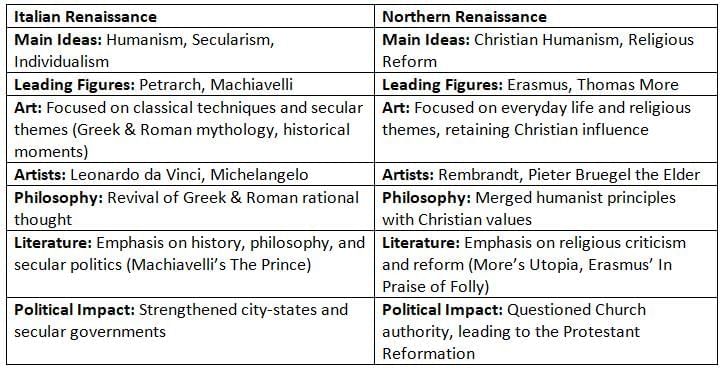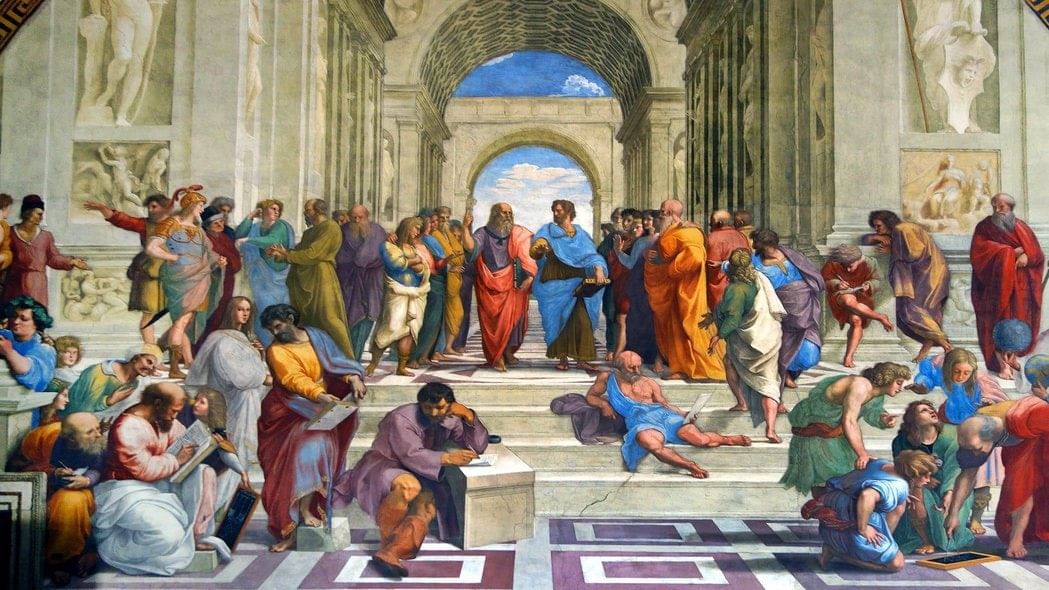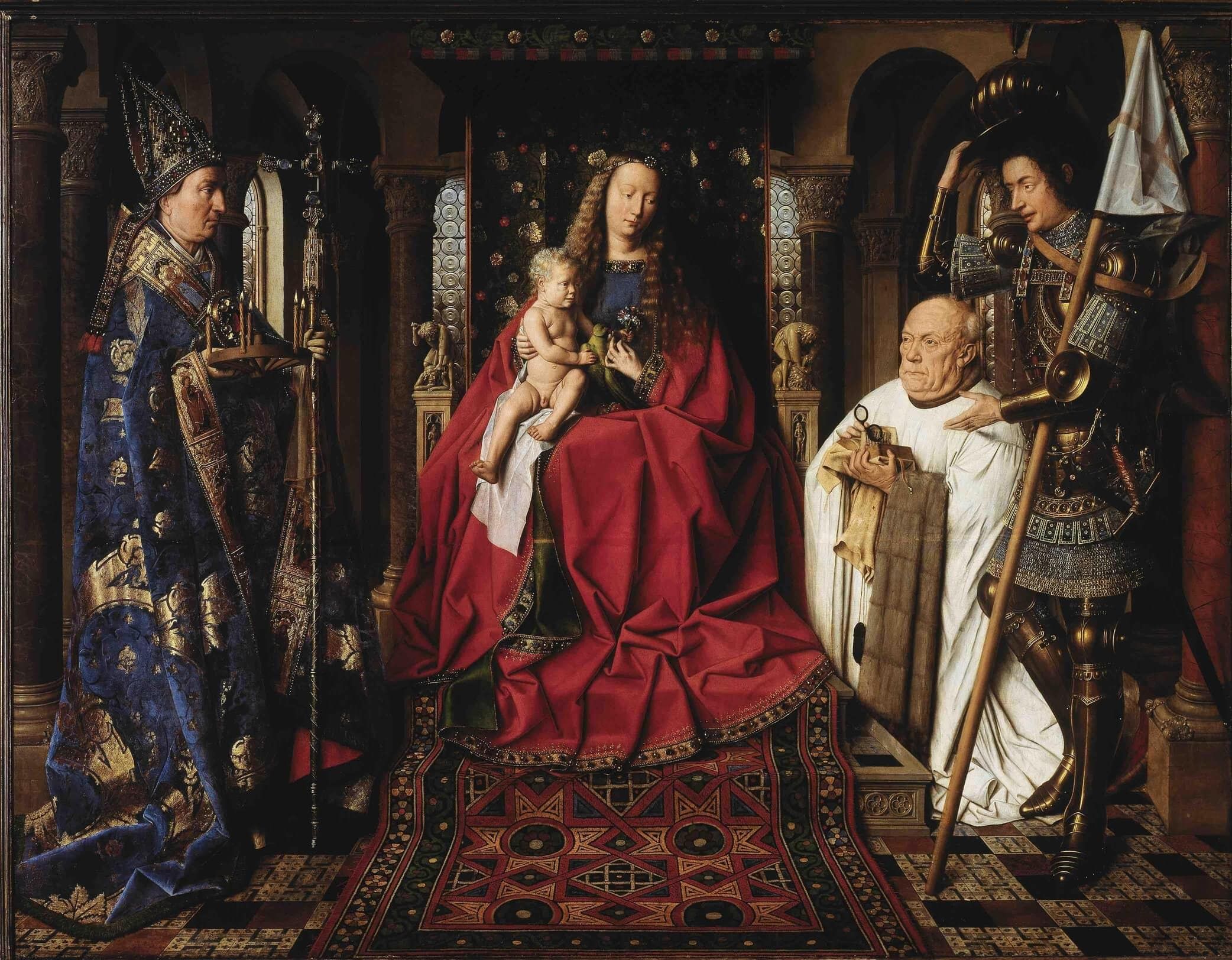Grade 9 Exam > Grade 9 Notes > AP European History > Chapter Notes: Northern Renaissance
Northern Renaissance Chapter Notes | AP European History - Grade 9 PDF Download
Introduction
The Northern Renaissance, emerging in the late 15th century in regions like Germany, France, and the Netherlands, marked a cultural and intellectual awakening distinct from its Italian predecessor. Fueled by the printing press and Christian Humanism, it blended classical revival with religious reform, challenging established institutions and paving the way for the Protestant Reformation. This chapter notes explores its unique characteristics, key figures, and lasting impacts.
The Northern Renaissance
- By the late 15th century, several decades after the Italian Renaissance began, Northern Europe—encompassing Germany, France, England, Belgium, and the Netherlands—started to engage with the rediscovered classical texts of ancient Greece and Rome.
- Though Renaissance ideals reached the North later, they spread rapidly, largely due to Johann Gutenberg’s printing press. This invention enabled the Church, northern humanists, and political leaders to share their ideas and perspectives with a broader audience, including religious texts.
Christian Humanism
- In contrast to the Italian Renaissance, Northern scholars placed a stronger emphasis on religion, developing Christian Humanism, a doctrine that combined Christ’s teachings with a focus on individualism and human potential.
- Erasmus, a Dutch Christian humanist and scholar known as the "prince of humanism," authored numerous critiques of the Catholic Church’s corruption and abuse of power. Despite his criticisms, he remained a devoted Christian committed to the Church. His translation of the New Testament significantly influenced modern biblical scholarship.
Impact of the Northern Renaissance
- The principles of Christian Humanism set the stage for the Protestant Reformation. As individuals accessed original Latin translations of the Bible, they identified notable inconsistencies between biblical texts and Catholic Church practices. Additionally, Northern Europe’s cultural diversity fostered the integration and dissemination of varied and competing ideas.
- The Northern Renaissance, with its focus on secularism and individualism, questioned religious, political, and intellectual authorities, particularly emphasizing religious reform. As Christian Humanism gained momentum, it spurred the formation of new religious sects independent of the Catholic Church.
- Participants in the Northern Renaissance came from diverse backgroundsand were deeply committed to religious reform, distinguishing them from Italian Renaissance figures, who prioritized classical humanism and secular themes.
- Led to Religious Reform:
- Christian Humanism challenged the authority of the Catholic Church.
- Access to original Latin Bibles revealed discrepancies with Church teachings.
- Diverse Intellectual & Cultural Influence:
- Northern Europe’s diverse population encouraged the blending of competing ideas.
- Helped Spark the Protestant Reformation:
- The drive for religious reform led to the emergence of new Christian denominations separate from Catholicism.
- Led to Religious Reform:
The Italian vs Northern Renaissance

- The Italian Renaissance centered on humanism, secularism, and classical revival, whereas the Northern Renaissance prioritized religious reform and Christian Humanism.
- The printing press was instrumental in disseminating ideas in both movements but had a greater impact in the North, enabling widespread religious critique.
- While the Italian Renaissance fostered political centralization and diplomacy, the Northern Renaissance contributed to Protestantism and religious fragmentation in Europe.
Italian Renaissance Art

Northern Renaissance Art

Key Terms
- Belgium: Belgium, a small European nation, is known for its rich history and cultural diversity. Its strategic location made it a key player during the Renaissance and later conflicts, reflecting themes of nationalism and imperialism in Europe’s linguistic and cultural divisions.
- Catholic Teachings: Catholic teachings encompass the doctrines of the Roman Catholic Church, rooted in the Bible, Church traditions, and teachings of the Church Fathers. Covering morality, sacraments, and theology, they were scrutinized during the Northern Renaissance, influencing cultural and religious shifts.
- Christian Humanism: Christian Humanism, a Renaissance movement, blended classical humanism’s focus on human potential with Christian ethics. By studying classical texts alongside the Bible, it aimed to reform society through education and moral improvement.
- Classical Text: Classical texts are foundational works from ancient civilizations, shaping Western culture. Their rediscovery during the Northern Renaissance fueled a revival of classical learning and humanism, emphasizing human achievement and intellectual growth.
- England: England, part of the United Kingdom, played a significant role in European history during the Renaissance, the English Civil War, and as a global power, shaping modern Europe’s political, cultural, and economic landscape.
- Erasmus: Erasmus, a Dutch Renaissance humanist and theologian, critiqued church doctrine while advocating for reform within Christianity. His works, such as In Praise of Folly, emphasized simple Christian values, influencing the Protestant Reformation.
- France: France, a Western European nation, has been central to European history, influencing the Renaissance, absolutism, revolutions, and the development of modern nation-states through its cultural and political contributions.
- Germany: Germany, a central European nation, has been a focal point in events like the Reformation and both World Wars, significantly shaping European and global history through its political and cultural influence.
- Johann Gutenberg: Johann Gutenberg, a German inventor, introduced the movable type printing press in the mid-15th century, revolutionizing book production. His innovation boosted literacy and idea dissemination during the Northern Renaissance.
- Latin Text of the Church: The Latin text of the Church refers to the official liturgical and scriptural texts used by the Roman Catholic Church in Latin. These texts ensured doctrinal unity and were central to Northern Renaissance efforts to reform Church practices.
- Naturalism: Naturalism, a philosophical and artistic movement, emphasizes realistic depictions based on observation, focusing on natural causes and human experience, a key feature of Northern Renaissance art.
- Netherlands: The Netherlands, in Northwestern Europe, was a hub for artistic and intellectual innovation during the Northern Renaissance and reached its zenith during the Dutch Golden Age, influencing trade, science, and art.
- New Testament: The New Testament, comprising 27 books of the Christian Bible, details Jesus Christ’s life, teachings, and the early Christian church. It shaped religious thought during the Renaissance, influencing Northern European art and literature.
- Northern Renaissance: The Northern Renaissance, occurring in the late 15th and 16th centuries, was a cultural movement in Northern Europe emphasizing oil painting, realism, and everyday life, blending religious themes with humanist ideas.
- Pieter Bruegel the Elder: Pieter Bruegel the Elder, a 16th-century Flemish painter, depicted peasant life, morality, and human folly. His realistic and symbolic works are iconic of the Northern Renaissance’s focus on everyday themes.
- Printing Press: Invented by Johannes Gutenberg in the mid-15th century, the printing press transformed book production, spreading ideas, enhancing literacy, and driving cultural and religious changes during the Renaissance.
- Protestant Reformation: The Protestant Reformation, a 16th-century movement, sought to reform the Roman Catholic Church, leading to Protestant denominations. It challenged papal authority and emphasized personal faith, reshaping European society.
- Rembrandt: Rembrandt van Rijn, a Dutch painter of the Northern Renaissance and Dutch Golden Age, is renowned for his use of light, emotional depth, and innovative compositions, capturing human emotion and everyday life.
- Secularism: Secularism separates religion from political, social, and educational institutions, prioritizing reason and evidence. It influenced Northern Renaissance thought, encouraging critical inquiry and individualism.
The document Northern Renaissance Chapter Notes | AP European History - Grade 9 is a part of the Grade 9 Course AP European History.
All you need of Grade 9 at this link: Grade 9
FAQs on Northern Renaissance Chapter Notes - AP European History - Grade 9
| 1. What are the key differences between the Italian Renaissance and the Northern Renaissance? |  |
Ans. The Italian Renaissance was characterized by a revival of classical learning and humanism, focusing on art, literature, and science, with figures like Leonardo da Vinci and Michelangelo. In contrast, the Northern Renaissance, which took place in regions such as Flanders and Germany, emphasized detailed realism in art and included a strong focus on religious themes, as seen in the works of artists like Albrecht Dürer and Jan van Eyck. Additionally, the Northern Renaissance placed a greater emphasis on the use of oil paints, which allowed for richer colors and finer details.
| 2. How did the Northern Renaissance influence art and literature? |  |
Ans. The Northern Renaissance had a profound impact on art and literature by promoting a more naturalistic approach and incorporating intricate details and vibrant colors. Artists began to focus on everyday life and common people, showcasing realistic portrayals rather than idealized forms. In literature, writers like Erasmus and Thomas More explored themes of social reform and humanist ideals, often using satire and critique to address societal issues. This period also saw the rise of the printing press, which facilitated the spread of literature and ideas, making works more accessible to the public.
| 3. What role did the printing press play in the Northern Renaissance? |  |
Ans. The printing press was a revolutionary invention that significantly contributed to the spread of knowledge during the Northern Renaissance. By enabling the mass production of books and pamphlets, it allowed ideas, art, and literature to reach a wider audience than ever before. This facilitated the spread of Renaissance humanism and new scientific ideas, as well as religious texts that challenged the authority of the Church. The availability of printed materials helped foster critical thinking and debate, ultimately leading to significant social and religious changes.
| 4. Who were some prominent figures of the Northern Renaissance, and what were their contributions? |  |
Ans. Prominent figures of the Northern Renaissance included artists such as Albrecht Dürer, known for his detailed engravings and paintings that combined naturalism with meticulous craftsmanship. Another key figure was Jan van Eyck, whose use of oil paint revolutionized the art of portraiture and landscape. In literature, Erasmus was a significant humanist thinker whose works, including "In Praise of Folly," critiqued society and the Church, while Thomas More's "Utopia" envisioned an ideal society. Their contributions helped shape the intellectual landscape of the time.
| 5. How did the Northern Renaissance approach religion differently than the Italian Renaissance? |  |
Ans. The Northern Renaissance approached religion with a strong emphasis on personal faith and moral integrity, often critiquing the corruption within the Church. While the Italian Renaissance celebrated the grandeur of the Church and its patronage of the arts, the Northern Renaissance artists and thinkers sought to depict religious themes with sincerity and realism, focusing on the human experience. This led to a rise in Protestant thought and reform movements, as figures like Martin Luther challenged established doctrines, emphasizing individual interpretation of the scriptures and leading to significant religious upheaval.
Related Searches















